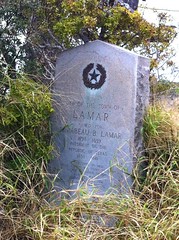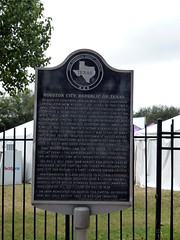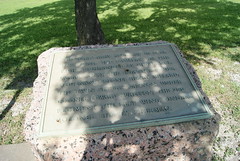Mirabeau Buonaparte Lamar


Mirabeau Buonaparte Lamar
(1798-1859)
President of the Republic of Texas (1838-1841)
Died aged c. 61
Commemorated on 18 plaques
Texas Historical Marker #02638
Indian Signaling Grounds. Heights used from pre-settlement days to 1870s by Comanches and others to send messages over long distances. Smoke once rose from here (Five Mill Hill); Chapel Hill, 2 mi. south; and old community of Sloan in west San Saba County. Tribes wintered at main village near Sloan; burial ground is on Chapel Hill. An early settler recalls Indians peering through cracks in cabin at night while she, children, and friend put ashes on fire and hid. She believed Indians would not enter a dark house. Another time she heard livestock being taken. Many pioneers saw signals on nearby hills. Indians communicated by means of smoke, at times mirrors. Codes were used to confuse enemies. Messages sent news and could gather or disperse tribes. The Comanches had an excellent smoke signal system, also imitated animal cries. These often warned settlers to prepare for attack. In some areas, whites later pre-empted signal grounds for use against the Indians. Mirabeau B. Lamar visited this area in 1837; later, as president of Republic of Texas, he had a forceful Indian policy. On banks of San Saba in 1847, German Emigration Company bought peace from the Comanches for $3,000 worth of beads, trinkets; and in 1850 on Wallace Creek, about 15 mi. southwest, the U.S. signed an Indian treaty. #2638
US 190 E. of San Saba about 4.5 mi., San Saba, TX, United States where they visited
Texas Historical Marker #03017
Lamar School. The first Plainview schoolhouse was built in 1887, the year the town was founded. Located northwest of this site, it was a half-dugout sod building similar to many of the pioneer homes of the area. Built by local men under the supervision of Judge J. M. Carter and Col. R. P. Smyth, the structure also served as a community center and was used for the organization of at least two local churches. In 1889 the Plainview Masonic Lodge constructed a two-story frame building west of this site. The second floor was used for lodge meetings and the ground floor was occupied by the school, which became known as The Llano Estacado Institute for Male and Female in 1893. The building served as the schoolhouse until it burned in 1902. Shortly after the organization of the Plainview Independent School District in 1902, the elementary school was renamed in honor of the noted Texas leader Mirabeau B. Lamar. A two-story schoolhouse at this site was moved in 1910 when the original section of the present building was constructed. Later used as a vocational training center, Lamar School reflects the pioneer educational, social, and religious growth of the community. 1981 #3017
506 E. 4th, Plainview, TX, United States where they is commemorated
Texas Historical Marker #03018
Site of the Town of Lamar. Named for Mirabeau B. Lamar 1798-1859, President of the Republic of Texas 1838-1841. Established in 1838; made a port of entry in 1839. Sacked by Union troops Feb. 11, 1864. Survived until 1914 but never flourished. #3018
?, Rockport, TX, United States where they is commemorated
Texas Historical Marker #05368
Lamar Cemetery, The. This burial ground originally served pioneer settlers of the Lamar community. Founded by James W. Byrne (d. 1865), a native of Ireland and a veteran of the Texas Revolution, it was named for his friend Mirabeau B. Lamar, former president of the Republic of Texas. The earliest grave is that of Patrick O'Connor (1822-54), a bookkeeper for Byrne's business operations in New Orleans. The town of Lamar ceased to exist by 1915 and the cemetery was neglected until the 1940s when it was restored through efforts by the family of John Henry Kroeger, Jr. (d. 1944). (1981) Incise in base: Donated by the Lamar Woman's Club #5368
?, Lamar, TX, United States where they is commemorated
Texas Historical Marker #08204
Lamar County. Created December 17, 1840 from Red River County. Organized in 1841. Named in honor of Mirabeau B. Lamar, 1798-1859. Father of Texas education. President of the Republic of Texas 1838-1841. Lafayette, 1841, Mount Vernon, 1843, Paris, originally called Pinhook, 1844, have served as county seat. #8204
US 82, Paris, TX, United States where they is commemorated
Texas Historical Marker #08983
Calvary Episcopal Church. This congregation grew out of Episcopal missionary efforts that began soon after Texas gained its independence from Mexico. In 1859, through the effort of Judge W. E. Kendall, the first church building was erected, and the church became a parish. Early clergy included the Rev. Hannibal Pratt and the Rev. William t. Dalzell. Members have included statesman Mirabeau B. Lamar and many descendants of early Texas colonists. The congregation's rich heritage provides a significant link to the early history of the Episcopal church in Texas. #8983
806 S 11th st., Richmond, TX, United States where they member
Texas Historical Marker #09003
Mirabeau Buonaparte Lamar. President of the Republic of Texas A native of Georgia, Mirabeau B. Lamar came to Texas in 1835 and immediately became involved in the movement for independence from Mexico. Upon the fall of the Alamo and news of the Goliad Massacre, he joined the Texas Army, in the rank of private, as Houston's troops moved eastward toward San Jacinto. In a swiftly moving chain of events, he was made colonel on the eve of the Battle of San Jacinto, and there commanded the cavalry with distinction. Ten days later he was Secretary of War in the ad interim government, and a month later was appointed commander-in-chief of the army. Lamar was elected vice-president in the first national election in 1836. Anti-Sam Houston leaders sponsored him for president in 1837. He won the election and took office in 1838 for a 3-year term. His administration was known for its opposition to annexation, a forceful Indian policy, and the recognition of Texas by Great Britain and France. Lamar is credited with laying the foundation for the first system of public education in Texas. He did in 1859 at his plantation near Richmond, and is buried here in the Morton Cemetery. #9003
4606 Mustang Ave, Rosenberg, TX, United States where they was buried (1859)
Texas Historical Marker #09004
Site of the Home of Mirabeau B. Lamar. (1798-1859) Father of Texas education. President of the Republic of Texas, 1836-1841. He lived here from 1851 to 1859. #9004
?, Richmond, TX, United States where they lived
Texas Historical Marker #09012
Morton Cemetery. Burial place of illustrious pioneers, including 1838-1841 Republic of Texas President Mirabeau B. Lamar (1798-1859) and one of State's first women settlers, Jane Long (1798-1880), known as "The Mother of Texas." On Labor No. 1 of Mexican land grant to William Morton, 1822 settler in advance party of Austin's "Old 300" colonists; founded 1825 when Morton buried Robert Gelaspie (Gillespie), a brother Mason who had met with foul play. Later he erected a handmade brick tomb, the first known Masonic landmark in Texas. In an 1833 Brazos flood, Morton himself met death and his body was lost. His widow Nancy inherited Labor No. 1 and sold it to Handy & Lusk, promoters of the Richmond townsite. In 1854 the parcel of land encompassing the cemetery was acquired by Michael DeChaumes. In the 1890s Morton Lodge No. 72, A. F. & A. M., gained possession of "DeChaumes Cemetery" and operated it as Richmond Masonic Cemetery until the early 1940s. It was then turned over to the newly-formed Richmond Cemetery Association, which later was retitled Morton Cemetery Association, probably to have its name conform to "Morton Cemetery" -- the name in use ever since the era of Lodge ownership. The cemetery has become a memorial to its founder. #9012
?, Richmond, TX, United States where they was buried (1859)
Texas Historical Marker #09362
Texan Santa Fe Expedition. A dramatic chapter in administration (1838-1841) of Republic of Texas president Mirabeau B. Lamar. Aware of United States-Mexico commerce crossing Texas by the Santa Fe Trail near the Canadian River, President Lamar sought similar trade advantages for Texas. He initiated the Texan Santa Fe Expedition early in 1841, with Dr. Richard F. Brenham, Col. Wm. G. Cooke and Jose Antonio Navarro as commissioners. Cooke began recruiting in April, forming an artillery and five infantry companies. Remainder of 321 members included merchants (with $200,000 worth of goods), teamsters, guides and others. George W. Kendall, of the New Orleans "Picayune", joined to write classic book on the venture. Travel was by 21 slow ox-wagons. First day's march, June 19, 1841, ended on the San Gabriel, and expedition's campsite is near here. Before reaching the Santa Fe Trail some 600 miles north, the men were to have torturing experiences with drouth and unknown terrain. Ill from hardships, the group was betrayed into the hands of Mexican authorities and sent as prisoners to Mexico City. However, this penetration of upper Texas gave the Republic stronger claims to her northern lands. #9362
3 mi. E on SH 29, Georgetown, TX, United States where they established
Texas Historical Marker #09547
Columbia. In September 1836 Columbia, now known as West Columbia, became capital of the Republic of Texas. This took place with the removal of the ad interim government here from Velasco. After the election called by ad interim President David G. Burnet, the first permanent government of the Republic went into operation here in Columbia in October. Inaugurated were President Sam Houston and Vice-President Mirabeau B. Lamar. Under their leadership the first duly elected Congress convened and the first Constitution of the Republic was ratified. Citizens of this vicinity served the Republic. Henry Smith of nearby Brazoria prior of this time has been the first Anglo-American governor of Texas, in the 1835-36 Revolutionary provisional government. In President Houston's cabinet he was secretary of the treasury. Stephen F. Austin, colonizer and Father of Texas, was secretary of state; under the heavy demands of that office, his health broke and he died here on December 27, 1836. In April 1837 at the wish of President Houston, the seat of government was moved to more adequate quarters in the city of Houston. (1965) #9547
301 S. 17th St., West Columbia, TX, United States where they inaugurated
Texas Historical Marker #10664
Site of the First White House of the Republic of Texas. Here dwelt President Sam Houston from November, 1837 to December, 1838, and President Mirabeau B. Lamar, from December, 1838 to October, 1839. #10664
?, Houston, TX, United States where they lived
Texas Historical Marker #10692
Houston City, Republic of Texas. By vote of Congress, Nov. 30, 1836, chosen temporary capital for new Republic of Texas. At the time a small townsite at the head of Buffalo Bayou navigation. Into a "Houston City" of mud, tents, cabins on April 1, 1837, came President Sam Houston and his government. Finding its quarters unfinished, Congress postponed its opening session until May 1. The capitol building was a 2-story plantation style house, with columned porches. It was scene of many important Indian treaties, diplomatic negotiations, legislative functions. As no church yet graced the city, it also was used for religious services. That muddy April saw the city hold its first big social event-- the anniversary celebration of the San Jacinto victory, with parade, reception and ball. On Dec. 5, 1837, some war heroes and other leaders founded in the capital the Texas Philosophical Society, the Republic's first learned organization. In a powdered wig, and dressed to resemble George Washington, President Houston made a 3-hour farewell address, after which Mirabeau Buonaparte Lamar was inaugurated his successor on Dec. 10, 1838. In 1839, removed to Austin, the capital returned here, but only briefly, 1842, in Mexican invasion. #10692
?, Houston, TX, United States where they inaugurated
Texas Historical Marker #10768
Texas Army Attacked in Four Divisions. - The Cavalry on the right, commanded by Mirabeau B. Lamar; next, the Infantry under Lieutenant Colonel Henry Millard and the "Twin Sisters" cannon under Colonel George W. Hockley; the 1st Regiment in the center under Colonel Edward Burleson; the 2nd Regiment, the left wing, under Colonel Sidney Sherman. #10768
?, Houston, TX, United States where they was
Texas Historical Marker #10789
Temple Lodge No. 4, A. F. & A. M.. This Masonic Lodge traces its history to the early days of the Republic of Texas, when the seat of government was located in the newly founded city of Houston. Formally chartered on May 10, 1838, Temple Lodge was the fourth Masonic organization established in Texas, and the first to be established in the new Republic. It was chartered by the Grand Lodge of the Republic of Texas, which had been formed from the three existing lodges, all of which had been chartered originally by the Louisiana Grand Lodge. Playing leading roles in the organization's formation and development were many noted Texas patriots and statesmen. Early colonist George Fisher was named first worshipful master, with San Jacinto veteran Richard Bache as secretary and future Governor Francis R. Lubbock as first junior deacon. Temple Lodge held its regular meetings in the Senate Chamber of the Capitol in downtown Houston, where statesmen Anson Jones and Mirabeau Lamar were in frequent attendance. In July 1838, Temple Lodge conducted the first Masonic burial in the Republic of Texas for State Supreme Court Chief Justice James Collingsworth. Since its establishment Temple Lodge No. 4 has reflected the Masonic values and teachings of its founders. #10789
4055 W. Bellfort St., Houston, TX, United States where they was
Texas Historical Marker #11714
Felps Cemetery. This cemetery developed on land granted to Christian Hopfield by Mirabeau B. Lamar and the Republic of Texas in 1841. Hopfield sold the land to A. J. McMillan in 1873. Though there probably are earlier burials, the earliest known grave is that of Nancy (Griffin) Hall (1855-1878), who died at age 23. Other 19th century burials include those of 9-year-old Mittie Roberts (1876-1885), 2-year-old Ellen Hall (1882-1884), and 4-year-old Selern Hall (1895-1899). William Felps acquired the land around this site in 1918 and the cemetery gradually took on his name. Other graves of interest are those of Confederate veteran Henry Patterson and several other military veterans, including Lance Rosier (1886-1970), a World War I veteran known as "Mr. Big Thicket" for his efforts to conserve east Texas' Big Thicket National Preserve. (2000) #11714
?, Saratoga, TX, United States where they donated
Texas Historical Marker #15563
Mirabeau Buonaparte Lamar. #15563
?, Richmond, TX, United States where they was
Texas Historical Marker #16094
Site of the Official Residence of Mirabeau B. Lamar. Site of the Official Residence of Mirabeau B. Lamar, 1798-1859 President of the Republic of Texas, 1838-1841. The building was constructed in 1840 and destroyed by fire in March, 1847. Since 1882 the site has been occcupied by Saint Mary's Academy. #16094
7th & Brazos, Austin, TX, United States where they lived






